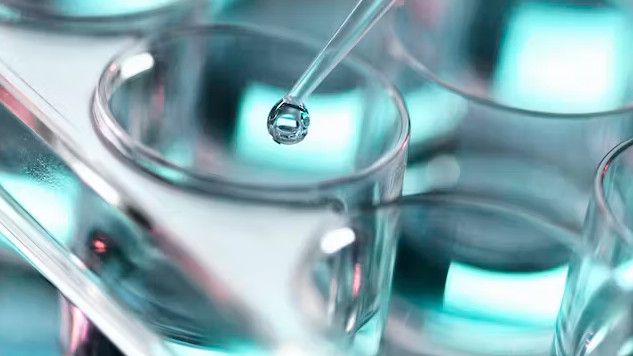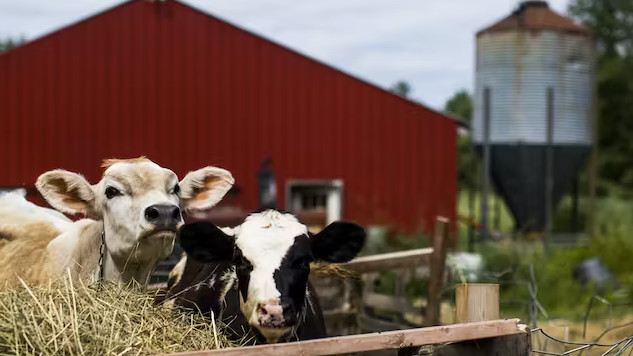
How long do chemicals really need to last? Andrew Brookes via Getty Images
PFAS chemicals seemed like a good idea at first. As Teflon, they made pots easier to clean starting in the 1940s. They made jackets waterproof and carpets stain-resistant. Food wrappers, firefighting foam, even makeup seemed better with perfluoroalkyl and polyfluoroalkyl substances.
Then tests started detecting PFAS in people’s blood.
Today, PFAS are pervasive in soil, dust and drinking water around the world. Studies suggest they’re in 98% of Americans’ bodies, where they’ve been associated with health problems including thyroid disease, liver damage and kidney and testicular cancer. There are now over 9,000 types of PFAS. They’re often referred to as “forever chemicals” because the same properties that make them so useful also ensure they don’t break down in nature.
Facing lawsuits over PFAS contamination, the industrial giant 3M, which has made PFAS for many uses for decades, announced a US$10.3 billion settlement with public water suppliers on June 22, 2023, to help pay for testing and treatment. The company admits no liability in the settlement, which requires court approval. Cleanup could cost many times that amount.
But how do you capture and destroy a forever chemical?
Biochemist A. Daniel Jones and soil scientist Hui Li work on PFAS solutions at the Michigan State University and explained the promising techniques being tested today.
How do PFAS get from everyday products into water, soil and eventually humans?
There are two main exposure pathways for PFAS to get into humans – drinking water and food consumption.
PFAS can get into soil through land application of biosolids, that is, sludge from wastewater treatment, and can they leach out from landfills. If contaminated biosolids are applied to farm fields as fertilizer, PFAS can get into water and into crops and vegetables.
For example, livestock can consume PFAS through the crops they eat and water they drink. There have been cases reported in Michigan, Maine and New Mexico of elevated levels of PFAS in beef and in dairy cows. How big the potential risk is to humans is still largely unknown.
Cows were found with high levels of PFAS at a farm in Maine. Adam Glanzman/Bloomberg via Getty Images
Scientists in our research group at Michigan State University are working on materials added to soil that could prevent plants from taking up PFAS, but it would leave PFAS in the soil.
The problem is that these chemicals are everywhere, and there is no natural process in water or soil effective at breaking them down. Many consumer products are loaded with PFAS, including makeup, dental floss, guitar strings and ski wax.
How are remediation projects removing PFAS contamination now?
Methods exist for filtering them out of water. The chemicals will stick to activated carbon, for example. But these methods are expensive for large-scale projects, and you still have to get rid of the chemicals.
For example, near a former military base near Sacramento, California, there is a huge activated carbon tank that takes in about 1,500 gallons of contaminated groundwater per minute, filters it and then pumps it underground. That remediation project has cost over $3 million, but it prevents PFAS from moving into drinking water the community uses.
The U.S. Environmental Protection Agency has proposed establishing legally enforceable regulations for maximum levels of six PFAS chemicals in public drinking water systems. Two of these chemicals, PFOA and PFOS, would be recognized as individual hazardous chemicals, with regulatory actions enforced when levels of either exceed 4 parts per trillion, which is substantially lower than previous guidance.
Filtering is just one step. Once PFAS is captured, then you have to dispose of PFAS-loaded activated carbons, and PFAS still moves around. If you bury contaminated materials in a landfill or elsewhere, PFAS will eventually leach out. That’s why finding ways to destroy it is essential.
What are the most promising methods scientists have found for breaking down PFAS?
The most common method of destroying PFAS is incineration, but most PFAS are remarkably resistant to being burned. That’s why they’re in firefighting foams.
PFAS have multiple fluorine atoms attached to a carbon atom, and the bond between carbon and fluorine is one of the strongest. Normally to burn something, you have to break the bond, but fluorine resists breaking off from carbon. Most PFAS will break down completely at incineration temperatures around 1,500 degrees Celsius (2,730 degrees Fahrenheit), but it’s energy intensive and suitable incinerators are scarce.
There are several other experimental techniques that are promising but haven’t been scaled up to treat large amounts of the chemicals.
A group at Battelle has developed supercritical water oxidation to destroy PFAS. High temperatures and pressures change the state of water, accelerating chemistry in a way that can destroy hazardous substances. However, scaling up remains a challenge.
Others are working with plasma reactors, which use water, electricity and argon gas to break down PFAS. They’re fast, but also not easy to scale up.
What are we likely to see in the future?
A lot will depend on what we learn about where humans’ PFAS exposure is primarily coming from.
If the exposure is mostly from drinking water, there are more methods with potential. It’s possible it could eventually be destroyed at the household level with electro-chemical methods, but there are also potential risks that remain to be understood, such as converting common substances such as chloride into more toxic byproducts.
The big challenge of remediation is making sure we don’t make the problem worse by releasing other gases or creating harmful chemicals. Humans have a long history of trying to solve problems and making things worse. Refrigerators are a great example. Freon, a chlorofluorocarbon, was the solution to replace toxic and flammable ammonia in refrigerators, but then it caused stratospheric ozone depletion. It was replaced with hydrofluorocarbons, which now contribute to climate change.
If there’s a lesson to be learned, it’s that we need to think through the full life cycle of products. How long do we really need chemicals to last?
About The Author
A. Daniel Jones, Professor of Biochemistry, Michigan State University and Hui Li, Professor of Environmental and Soil Chemistry, Michigan State University
This article is republished from The Conversation under a Creative Commons license. Read the original article.
Books on The Environment from Amazon's Best Sellers list
"Silent Spring"
by Rachel Carson
This classic book is a landmark in the history of environmentalism, drawing attention to the harmful effects of pesticides and their impact on the natural world. Carson's work helped to inspire the modern environmental movement and remains relevant today, as we continue to grapple with the challenges of environmental health.
Click for more info or to order
"The Uninhabitable Earth: Life After Warming"
by David Wallace-Wells
In this book, David Wallace-Wells offers a stark warning about the devastating effects of climate change and the urgent need to address this global crisis. The book draws on scientific research and real-world examples to provide a sobering look at the future we face if we fail to take action.
Click for more info or to order
"The Hidden Life of Trees: What They Feel, How They Communicate?Discoveries from A Secret World"
by Peter Wohlleben
In this book, Peter Wohlleben explores the fascinating world of trees and their role in the ecosystem. The book draws on scientific research and Wohlleben's own experiences as a forester to offer insights into the complex ways that trees interact with one another and the natural world.
Click for more info or to order
"Our House Is on Fire: Scenes of a Family and a Planet in Crisis"
by Greta Thunberg, Svante Thunberg, and Malena Ernman
In this book, climate activist Greta Thunberg and her family offer a personal account of their journey to raise awareness about the urgent need to address climate change. The book provides a powerful and moving account of the challenges we face and the need for action.
Click for more info or to order
"The Sixth Extinction: An Unnatural History"
by Elizabeth Kolbert
In this book, Elizabeth Kolbert explores the ongoing mass extinction of species caused by human activity, drawing on scientific research and real-world examples to provide a sobering look at the impact of human activity on the natural world. The book offers a compelling call to action to protect the diversity of life on Earth.
al




















